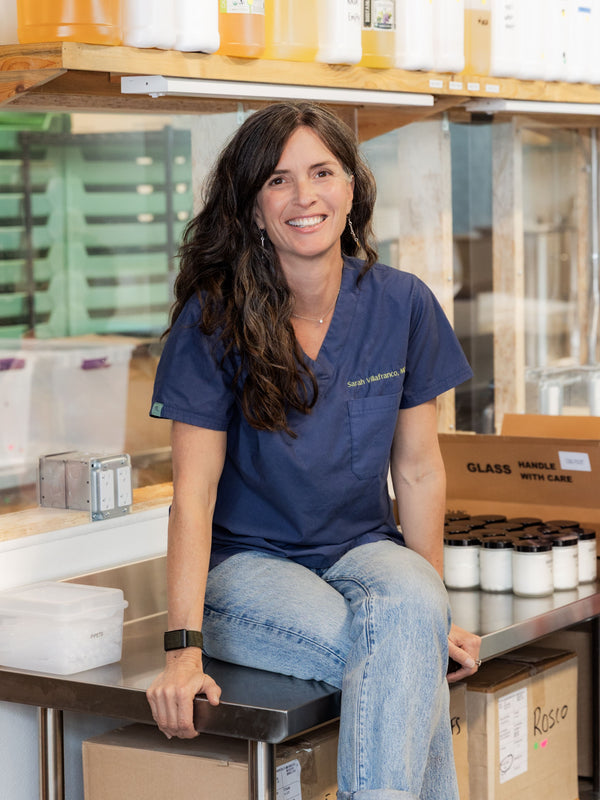What is “organic” sunscreen?
The word organic is incredibly confusing in many situations, but especially when referring to sunscreen. Technically, an “organic” sunscreen is one that uses carbon-based chemicals, like oxybenzone, avobenzone, and octinoxate, to diminish the impact of ultraviolet radiation. That's what "organic chemistry" is all about—the study of molecules with carbon backbones and carbon-hydrogen bonds. Benzene (C6H6), a petrochemical and a known carcinogen, is an ORGANIC compound! (Insert horrified gasp here, please.)
The barrier chemicals, like zinc and titanium, are called “inorganic”, because they are not carbon-based. Zinc oxide has the chemical formula ZnO—it's a zinc molecule and an oxygen molecule. In chemistry-speak, it is an inorganic compound.
All this said, when regular people (as opposed to chemists) refer to organic sunscreens or natural sunscreens for the face and body, they are usually talking about a barrier suncream (zinc and/or titanium) that has fewer and healthier ingredients than a mainstream sunscreen you might find in the grocery store. A less confusing term would be “non-toxic sunscreen” or "natural sunscreen" as it implies that we are comparing a more environmentally conscious product with a traditional sun protection product.
Why should I choose an organic sunscreen?
Most widely-available, commercial sunscreens contain not only sun protection chemicals, but parabens, fragrance, phthalates, and multiple ethoxylated ingredients, as well as being packaged in an aerosolized can: that knowledge alone is a great reason for choosing a non-toxic, natural sunscreen over a traditional brand. Specifically, the sunscreen ingredients oxybenzone and octinoxate are estrogenic and allergenic. Also, watch for a “non-active” ingredient called methylisothiazolinone—a common preservative in sunscreens and baby wipes that is highly allergenic to more and more people. Last, but definitely not least, many chemical sunscreens are hugely toxic to the marine environment, and how can you feel good reading a book on the beach when you know that you might hurt the coral reef just by going in the water??
What is a barrier sunblock?
Zinc oxide and titanium dioxide are the two physical sunblocks used in the natural sunscreen industry. They block the sun's rays, rather than screen them, and are usually what people are looking for when they search for an organic sunblock or a natural sunblock. Zinc blocks both UVA and UVB rays, making it a more desirable sun protection ingredient than titanium dioxide, which blocks mostly UVB rays. Rather than filtering the rays of the sun and diminishing the harmful effects of UV light (this is the action of a chemical sunscreen), a physical sunblock sits on top of the skin and reflects the sunlight. It’s like the difference between a filter and a mirror—the filter breaks up the sunlight and deactivates it, and the mirror reflects it instead. Nanoparticles complicate this issue, because they do get absorbed by the skin cells to some degree, and more work needs to be done to find out if this could have detrimental effects. Some researchers believe that nanoparticles get taken into skin cells where they heat up and accelerate sun damage, but the evidence is not conclusive yet. (I predict the answer will be that nanoparticles are icky, not only for your skin, but for our ecosystem, as well.)
Is a barrier sunblock better than a chemical sunscreen?
This is a much-argued point, and there is not enough science out there to back any extreme position. There seems to be increasing evidence that oxybenzone, a very common chemical sunscreen, may act like estrogen in the body, which increases the likelihood that it will disrupt our innate hormone cycles. Another controversial chemical is retinyl palmitate, which can slow skin aging, but may actually accelerate the development of certain skin cancers when it comes in contact with ultraviolet light. PABA is not used as much as it once was, but there’s a fairly large population of people who are allergic to that ingredient by now. And don't forget about the coral reefs!
In short, there are several, really good arguments for using a non-nano physical sunscreen made with zinc oxide and titanium dioxide: they are not absorbed by the skin; they are not degraded by exposure to sunlight, making them more stable over time; and there are often fewer and less toxic ingredients that make up the “inactive” ingredients in the product. Of the chemical screens, avobenzone is the one that protects against UVA rays and has a lower toxicity profile than other screens—at least for now.
How do I make my sunscreen less chalky?
We know natural sunscreens can be a drag—they're often too thick, chalky, or zinc-y. But simply adding a drop or two of Nectar Nourishing Drops to your daily sunscreen is a game changer. Organic oils of safflower, argan, prickly pear, and pumpkin seed work together to create a powerfully softening blend with a silky texture that will make your sunscreen application smooth. And gorgeous rosehip seed oil helps diminish the appearance of chronic sun damage. Adding a drop of Nectar may decrease the SPF of your sunscreen very slightly, but not enough to worry about if it helps with your application. There are some sunscreens that just won't penetrate fully on darker skin tones, so you might have to try a few before finding one that doesn't leave you looking like a ghost!
What should I look for in a natural sunscreen?
Look for fewer ingredients overall, stick with non-nano zinc and titanium particles until we know more about the effects of nanoparticles, and look for a product with no parabens and no fragrance. (Even essential oils oxidize in sunlight, which can increase your chance of having a skin reaction.) An SPF of 30 is probably sufficient, and you should still be wearing hats and long sleeves when you're out in the sun for prolonged periods. And, remember that a smidge of sunlight—10-15 minutes of early or late day rays on bare skin a few times a week—keeps your Vitamin D levels in the healthy range, so don't sweat it if you spend a few minutes outdoors now and then without your sunscreen.
Most dermatologists will tell you that the best sunscreen is any sunscreen you will use, and I agree that using sunscreen is better than not using it! But I think we can do better: let's look for natural sunscreen ingredients that aren't harmful for human or environmental health. Why choose any sunscreen when you can easily choose a healthier one??
Below are a few of the Osmia team's favorite sunscreens:
Dr. Sarah Villafranco
Mary
Alexa
LISA












